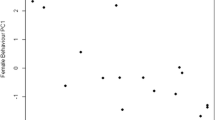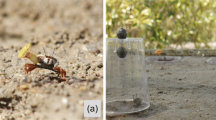Abstract
The use of video playback, digitally-modified video images, and animations is a potentially powerful tool for exploring the interactions between morphological and behavioral components of complex sexually selected traits. The utility of digitally-modified video was evaluated by the responses of females to male images in which either the behavioral components of display or the colors of ornamentation were manipulated. Females were presented with paired male images that varied only in the size of the orange or blue spot on the body (19.1% vs. 8.6%), courtship duration (7 sec vs. 2.3 sec), or courtship rate (3 displays min-1 vs. 1 display min-1). Females preferred male images with more vigorous courtship displays (both duration and rate) but did not discriminate between images differing in spot size. The results of the present study suggest that females discriminate more strongly between variation in male behavior than in their morphological attributes. The results of morphological manipulations should be interpreted with caution, however, because several factors could have contributed to the lack of female responses to color spot variation. Among them are lowered resolution of the computer image, which fails to capture the precision and complexity of the color pattern. Despite these potential difficulties, digitally-modified video promises to be a powerful method to study complex visual communication systems, where the function of and interaction between the various morphological and behavioral components is as yet poorly understood.
Similar content being viewed by others
References cited
Allen, J.M. & P.E. Nicoletto. 1997. Response of Betta splendens to computer animations of males with fins of different length. Copeia 1997: 195–199.
Baerends, G.P., R. Brouwer & H.T. Waterbolk. 1955. Ethological studies on Lebistes reticulatus (Peters). I. An analysis of the male courtship pattern. Behaviour 8: 249–335.
Clark, D.L. & G.W. Uetz. 1990. Video image recognition by the jumping spider, Maevia inclemens (Araneae: Salticidae). Anim. Behav. 40: 884–890.
Clark, D.L. & G.W. Uetz. 1992. Morph-independent mate selection in a dimorphic jumping spider: demonstration of movement bias in female choice using video-controlled courtship behaviour. Anim. Behav. 42: 247–254.
Clark, E. & L.R. Aronson. 1951. Sexual behavior in the guppy, Lebistes reticulatus (Peters). Zoologica 36: 49–66.
Endler, J.A. 1978. A predator's view of animal color patterns. Evol. Biol. 11: 319–354.
Endler, J.A. 1980. Natural selection on color patterns in Poecilia reticulata. Evolution 34: 76–91.
Endler, J.A. 1983. Natural and sexual selection on color patterns in poeciliid fishes. Env. Biol. Fish. 9: 173–190.
Endler, J.A. & A.E. Houde. 1995. Geographic variation in female preferences for male traits in Poecilia reticulata. Evolution 49: 456–468.
Evans, C.S. & P. Marler. 1991. On the use of video images as social stimuli in birds: audience effects on alarm calling. Anim. Behav. 41: 17–26.
Evans, C.S. & P. Marler. 1992. Female appearance as a factor in the responsiveness of male chickens during anti-predator behavior and courtship. Anim. Behav. 42: 137–146.
Houde, A.E. 1988. Genetic difference in female choice between two guppy populations. Anim. Behav. 36: 510–516.
Houde, A.E. 1992. Sex-linked heritability of a sexually selected character in a natural population of Poecilia reticulata (Pisces: Poeciliidae) (guppies). Heredity 69: 229–235.
Houde, A.E. & J.A. Endler. 1990. Correlated evolution of female mating preferences and male color patterns in the guppy Poecilia reticulata. Science 248: 1405–1408.
Kodric-Brown, A. 1985. Female preference and sexual selection for male coloration in the guppy (Poecilia reticulata). Behav. Ecol. Sociobiol. 17: 199–205.
Kodric-Brown, A. 1989. Dietary carotenoids and male mating success: an environmental component of female choice. Behav. Ecol. Sociobiol. 25: 393–401.
Kodric-Brown, A. 1993. Female choice of multiple male criteria in guppies: interacting effects of dominance, colouration and courtship. Behav. Ecol. Sociobiol. 32: 415–420.
Kodric-Brown, A. & P.F. Nicoletto. 1996. Consensus among females in their choice of males in the guppy Poecilia reticulata. Behav. Ecol. Sociobiol 39: 395–400.
Kodric-Brown, A. & P.F. Nicoletto. 1997. Repeatability of female choice in the guppy: response to live and videotaped males. Anim. Behav. 54: 369–376.
Liley, N.R. 1966. Ethological isolating mechanisms in four sympatric species of poeciliid fishes. Behaviour (Suppl.) 13: 1–197.
Luyten, P.H. & N.R. Liley. 1991. Sexual selection and competitive mating success of male guppies (Poecilia reticulata) from four Trinidad populations. Behav. Ecol. Sociobiol. 28: 329–336.
Macedonia, J.M., C.S. Evans & J.B. Losos. 1994. Male Anolis lizards discriminate video-recorded conspecific and heterospecific displays. Anim. Behav. 47: 1220–1223.
Magurran, A.E. & B.H. Seghers. 1991. Variation in schooling and aggression amongst guppy (Poecilia reticulata) populations in Trinidad. Behaviour 118: 214–234.
McKinnon, J.S. 1995. Video mate preferences of female three-spined sticklebacks from populations with divergent male coloration. Anim. Behav. 50: 1645–1655.
McKinnon, J.S. & J.D. McPhail. 1996. Male aggression and colour in divergent populations of the threespine stickleback: experiments with animations. Can. J. Zool. 74: 1727–1733.
Nicoletto, P.F. 1993. Female sexual response to condition-dependent ornaments in the guppy, Poecilia reticulata. Anim. Behav. 46: 441–450.
Nicoletto, P.F. 1995. Offspring quality and female choice in the guppy, Poecilia reticulata. Anim. Behav. 49: 377–387.
Nicoletto, P.F. 1996. The influence of water velocity on the display behaviour of male guppies, Poecilia reticulata. Behav. Ecol. 7: 272–278.
Rosenthal, G.G., C.S. Evans & W.L. Miller. 1996. Female preferences for a dynamic trait in the green swordtail, Xiphophorus helleri: attractive males swim backwards. Anim. Behav. 51: 811–820.
Rowland, W.J. 1995. Do female sticleback care about male courtship vigour? Manipulation of display tempo using video playback. Behaviour 132: 951–961.
Rowland, W.J., K.J. Bolyard, J.J. Jenkins & J. Fowler. 1995. Video playback experiments on stickleback mate choice: female motivation and attentiveness to male colour cues. Anim. Behav. 49: 1559–1567.
Stoner, G. & F. Breden. 1988. Pheotypic differentiation in female preference related to geographic variation in male predation risk in the Trinidad guppy (Poecilia reticulata). Behav. Ecol. Sociobiol. 22: 285–291.
Author information
Authors and Affiliations
Rights and permissions
About this article
Cite this article
Nicoletto, P.F., Kodric-Brown, A. The Use of Digitally-modified Videos to Study the Function of Ornamentation and Courtship in the Guppy, Poecilia reticulata. Environmental Biology of Fishes 56, 333–342 (1999). https://doi.org/10.1023/A:1007444904705
Issue Date:
DOI: https://doi.org/10.1023/A:1007444904705




